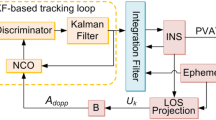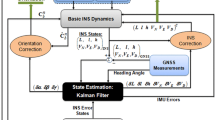Abstract
In the ultra-tight integration system of the global navigation satellite system/ inertial navigation system (GNSS/INS), the error models of INS aiding information are significant to analyze the performance of system. However, it is difficult to comprehensively describe the error propagation process between INS and GNSS when using the traditional transfer functions and inertial computation formulas. To overcome the issues, a comprehensive error modeling scheme of INS aiding information for GNSS tracking loops is proposed from the state space design perspective. Using the proper integrated navigation filter derived in Earth-centered, Earth-fixed frame, the error propagation process from integrated navigation filter to INS-aiding information can be constructed, by taking the overall error sources into consideration. In addition, the error item of acceleration caused by rotations of the line-of-sight direction is analyzed, which is especially important for high-dynamic receivers or middle-orbit satellites positioning. Simulation and experiment results verify the effectiveness of the proposed error modeling method. This method has significant application potential for the performance analysis of tracking loops in GNSS/INS ultra-tight integration system.



















Similar content being viewed by others

Data availability
Simulated data will be made available at reasonable request. The experimental data are open source and can be accessed at https://rnl-data.ae.utexas.edu/texcup/.
References
Babu R, Wang J (2009) Ultra-tight GPS/INS/PL integration: a system concept and performance analysis. GPS Solutions 13(1):75–82. https://doi.org/10.1007/s10291-008-0097-9
Ban Y, Niu X, Zhang T, Zhang Q, Liu J (2017) Modeling and quantitative analysis of GNSS/INS deep integration tracking loops in high dynamics. Micromachines (Basel) 8(9):272. https://doi.org/10.3390/mi8090272
Cong L, Li X, Jin T, Yue S, Xue R (2016) An adaptive INS-aided PLL tracking method for GNSS receivers in harsh environments. Sensors (Basel) 16(2):146. https://doi.org/10.3390/s16020146
Dou J, Xu B, Dou L (2020) Performance assessment of GNSS scalar and vector frequency tracking loops. Optik 202:163552. https://doi.org/10.1016/j.ijleo.2019.163552
Lashley M, Bevly DM (2013) Performance comparison of deep integration and tight coupling. Navigation 60(3):159–178. https://doi.org/10.1002/navi.43
Liu B, Zhan X, Liu M (2018) GNSS/MEMS IMU ultra-tightly integrated navigation system based on dual-loop NCO control method and cascaded channel filters. IET Radar Sonar Navig 12(11):1241–1250. https://doi.org/10.1049/iet-rsn.2018.5169
Liu B, Gao Y, Gao Y, Tong K, Wu M (2022a) Non-consecutive GNSS signal tracking-based ultra-tight integration system of GNSS/INS for smart devices. GPS Solutions 26(3):82. https://doi.org/10.1007/s10291-022-01267-7
Liu B, Gao Y, Zhan X (2022b) Code phase tracking error based autonomous integrity monitoring for GNSS/INS ultra-tightly integrated system. Adv Sp Res 69(10):3785–3797. https://doi.org/10.1016/j.asr.2022.02.040
Narula L, LaChapelle DM, Murrian MJ, Wooten JM, Humphreys TE, de Toldi E, Morvant G, Lacambre JB (2020) TEX-CUP: the University of Texas challenge for urban positioning. In: IEEE/ION position, location and navigation symposium (PLANS), Portland, OR, USA, pp 277–284. https://doi.org/10.1109/PLANS46316.2020.9109873
Niu X, Ban Y, Zhang Q, Zhang T, Zhang H, Liu J (2015) Quantitative analysis to the impacts of IMU quality in GPS/INS deep integration. Micromachines 6(8):1082–1099. https://doi.org/10.3390/mi6081082
Qin F, Zhan X, Zhan L (2014) Performance assessment of a low-cost inertial measurement unit based ultra-tight global navigation satellite system/inertial navigation system integration for high dynamic applications. IET Radar Sonar Navig 8(7):828–836. https://doi.org/10.1049/iet-rsn.2013.0217
Qin H, Yue S, Cong L, Jin T (2019) A state-constrained tracking approach for Kalman filter-based ultra-tightly coupled GPS/INS integration. GPS Solutions 23(2):1–13. https://doi.org/10.1007/s10291-019-0844-0
Sun D, Petovello MG, Cannon ME (2008) GPS/reduced IMU with a local terrain predictor in land vehicle navigation. Int J Navig Obs 2008:1–15. https://doi.org/10.1155/2008/813821
Sun D, Petovello MG, Cannon ME (2010) Use of a reduced IMU to aid a GPS receiver with adaptive tracking loops for land vehicle navigation. GPS Solutions 14(4):319–329. https://doi.org/10.1007/s10291-009-0159-7
Sun D, Petovello MG, Cannon ME (2013) Ultratight GPS/reduced-IMU integration for land vehicle navigation. IEEE Trans Aerosp Electron Syst 49(3):1781–1791. https://doi.org/10.1109/taes.2013.6558019
Thompson BF, Lewis SW, Brown SA, Scott TM (2020) Computing GPS satellite velocity and acceleration from the broadcast navigation message. Navigation 66(4):769–779. https://doi.org/10.1002/navi.342
Wang X, Li Y (2012) An innovative scheme for SINS/GPS ultra-tight integration system with low-grade IMU. Aerosp Sci Technol 23(1):452–460. https://doi.org/10.1016/j.ast.2011.10.004
Wang K, Xu X, Gao W, Wang J (2020) Linearized in-motion alignment for a low-cost INS. IEEE Trans Aerosp Electron Syst 56(3):1917–1925. https://doi.org/10.1109/taes.2019.2936780
Wang K, Gao W, Xu X, Wang J (2023) Adaptive alignment for low-cost INS in ECEF frame under large initial attitude errors. NAVIG J Inst Navig. https://doi.org/10.33012/navi.554
Wei M, Schwarz KP (1990) A strapdown inertial algorithm using an earth-fixed Cartesian frame. Navigation 37(2):153–167. https://doi.org/10.1002/j.2161-4296.1990.tb01544.x
Wu Y, He C, Liu G (2020) On inertial navigation and attitude initialization in polar areas. Satell Navig. https://doi.org/10.1186/s43020-019-0002-4
Xie F, Sun R, Kang G, Qian W, Zhao J, Zhang L (2017) A jamming tolerant BeiDou combined B1/B2 vector tracking algorithm for ultra-tightly coupled GNSS/INS systems. Aerosp Sci Technol 70:265–276. https://doi.org/10.1016/j.ast.2017.08.019
Yang R, Ling K, Poh E, Morton YT (2017a) Generalized GNSS signal carrier tracking: part I—modeling and analysis. IEEE Trans Aerosp Electron Syst 53(4):1781–1797. https://doi.org/10.1109/taes.2017.2673998
Yang R, Morton YT, Ling K, Poh E (2017b) Generalized GNSS signal carrier tracking—part II: optimization and implementation. IEEE Trans Aerosp Electron Syst 53(4):1798–1811. https://doi.org/10.1109/taes.2017.2674198
Yang R, Xu D, Morton YT (2020) Generalized multifrequency GPS carrier tracking architecture: design and performance analysis. IEEE Trans Aerosp Electron Syst 56(4):2548–2563. https://doi.org/10.1109/taes.2019.2948535
Yang H, Zhou B, Wang L, Wei Q, Zhang R (2021) Design and implementation of an open-source MATLAB code for GNSS/MEMS-INS deep integrated navigation. Optik 242:166987. https://doi.org/10.1016/j.ijleo.2021.166987
Yu M, Lee J, Park H (1999) Comparison of SDINS in-flight alignment using equivalent error models. IEEE Trans Aerosp Electron Syst 35(3):1046–1054. https://doi.org/10.1109/7.784073
Zhang T, Niu X, Ban Y, Zhang H, Shi C, Liu J (2015) Modeling and development of INS-aided PLLs in a GNSS/INS deeply-coupled hardware prototype for dynamic applications. Sensors (Basel) 15(1):733–759. https://doi.org/10.3390/s150100733
Zhang T, Zhang H, Lin T, Yan K, Niu X (2016) Modeling and verifying the impact of time delay on INS-aided GNSS PLLs. GPS Solutions 20(4):725–736. https://doi.org/10.1007/s10291-015-0484-y
Acknowledgements
This work was supported by the National Key Research and Development Program of China (No. 2022YFB3904401, No. 2022YFB3904404). We appreciate Mr. Wenxuan Gao for his assistance in the preprocessing of experimental data in this work.
Funding
This work was supported by the National Key Research and Development Program of China (No. 2022YFB3904401, No. 2022YFB3904404).
Author information
Authors and Affiliations
Contributions
Conceptualization, RY and WG; Literature investigation WG; Methodology, WG; Theoretical analysis WG; Software and simulation WG; Experimental verification WG; Figures and tables, WG; Project administration, RY; Supervision, RY and XZ; Funding acquisition, XZ; Writing—original draft WG; Writing—revision and response WG; Writing—review & editing, RY and XZ. All authors have read and agreed to the published version of the manuscript.
Corresponding author
Ethics declarations
Conflict of interest
The authors have no competing interests to declare that are relevant to the content of this article.
Consent for publication
All authors have read and agreed to the published version of the manuscript.
Ethics approval and consent to participate
Not applicable.
Additional information
Publisher's Note
Springer Nature remains neutral with regard to jurisdictional claims in published maps and institutional affiliations.
Appendices
Appendix 1: Derivations of some important formulas in detail
The detailed derivation of (6) is organized as follows. Using assumptions \({\tilde{\mathbf{v}}}_{S} \approx {\mathbf{v}}_{S}\), \({\tilde{\mathbf{r}}}_{S} \approx {\mathbf{r}}_{S}\), and \({\tilde{\mathbf{r}}}_{R} = {\mathbf{r}}_{R} + \delta {\mathbf{r}}_{R}\), then \({\tilde{\mathbf{e}}}\) is expanded as,
Noticing the fact \({\mathbf{r}}_{R} - {\mathbf{r}}_{S} \gg \delta {\mathbf{r}}_{R}\), and expand the denominator of (36) around point \(\left\| {{\mathbf{r}}_{R} - {\mathbf{r}}_{S} } \right\|\),
The detailed derivation of (9) is organized as follows. The derivative of \(\left\| {{\mathbf{r}}_{R} - {\mathbf{r}}_{S} } \right\|\) can be obtained using the derivative expression of L2-norm,
Then the derivative of unit direction vector \({\mathbf{e}}\) is expressed as,
The detailed derivation of (12) is organized as follows. Let \({\tilde{\mathbf{F}}} = - \frac{{2\pi f_{L} }}{c}\frac{{\left( {{\mathbf{I}} - {\mathbf{\tilde{e}\tilde{e}}}^{T} } \right)}}{{\left\| {{\tilde{\mathbf{r}}}_{R} - {\mathbf{r}}_{S} } \right\|}}\), \({\tilde{\mathbf{x}}} = {\tilde{\mathbf{v}}}_{R} - {\mathbf{v}}_{S}\), then the estimation of \(\delta \dot{\omega }_{IA}\) is expressed as,
Notice the fact \({\tilde{\mathbf{e}}} \approx {\mathbf{e}}\), therefore we can obtain \({\tilde{\mathbf{F}}} = {\mathbf{F}}\). Using the derivative expression of the quadratic form, equation (40) can be further expressed as,
The detailed derivation of (32)–(34) is organized as follows. Substitute \(\delta {\mathbf{f}}^{b} = {\mathbf{b}}_{a} + {\mathbf{n}}_{ra}\) and (25) in (30), it can be obtained that,
Hence, the items \(E\left( {\delta {\mathbf{v}}_{R} \delta {\varvec{a}}_{R}^{T} } \right)\), \(E\left( {\delta {\varvec{a}}_{R} \delta {\mathbf{v}}_{R}^{T} } \right)\) and \(E\left( {\delta {\varvec{a}}_{R} \delta {\varvec{a}}_{R}^{T} } \right)\) are expanded as,
Expand the polynomials in (43)–(45), and we can substitute the state covariance items using the corresponding elements of the partitioned matrix \({\mathbf{P}}_{k}\) in (29), e.g. \(E\left( {\delta {\mathbf{v}}^{e} \delta {\mathbf{q}}_{b}^{e} } \right) = {\mathbf{P}}_{vq}\). It needs to be noted that \({\mathbf{n}}_{ra}\) and \(\delta {\mathbf{g}}^{e}\) are white noises. Thus, the covariance items associated with them are all equal to zero. Finally, we can obtain (32)–(34) by expanding (43)–(45).
Appendix 2: Qualitative evaluation on the proportions of part A in INS-acceleration aiding
For convenience, the following descriptions are specific to INS acceleration aiding (INS velocity aiding includes only part B). The expressions of part A and part B for INS aiding error are given as (12) and (13). Part A for INS aiding information is defined as (11), and part B for INS aiding information is given as,
In the following rough estimation, we will not consider the influence of the term \({\tilde{\mathbf{e}}}\) and \({\mathbf{I}} - {\mathbf{\tilde{e}\tilde{e}}}^{T}\) because it can hardly affect the magnitudes of expressions (11)–(13), and (46). Additionally, it is assumed that the magnitudes of terms \(\delta {\mathbf{v}}_{R}\) and \(\delta {\varvec{a}}_{R}\) are consistent. Here are three typical cases for evaluation.
-
(1)
GEO satellite, low-dynamic receiver
$$ \left\| {{\tilde{\mathbf{v}}}_{R} } \right\| = 10\;{\text{m}}/{\text{s}},\;\left\| {{\mathbf{v}}_{S} } \right\| = 0\;{\text{m}}/{\text{s}},\;\left\| {{\tilde{\mathbf{r}}}_{R} } \right\| = 6400\;{\text{km}},\;\left\| {{\mathbf{r}}_{S} } \right\| = 42400\;{\text{km}},\;\left\| {\tilde{\user2{a}}_{R} } \right\| = 1\;{\text{m}}/{\text{s}}^{2} ,\;\left\| {{\varvec{a}}_{S} } \right\| = 0\;{\text{m}}/{\text{s}}^{2} $$
-
(2)
IGSO satellite, high-dynamic receiver
$$ \left\| {{\tilde{\mathbf{v}}}_{R} } \right\| = 1000\;{\text{m}}/{\text{s}},\;\left\| {{\mathbf{v}}_{S} } \right\| = 2500\;{\text{m}}/{\text{s}},\;\left\| {{\tilde{\mathbf{r}}}_{R} } \right\| = 6400\;{\text{km}},\;\left\| {{\mathbf{r}}_{S} } \right\| = 42400\;{\text{km}},\;\left\| {\tilde{\user2{a}}_{R} } \right\| = 1\;{\text{m}}/{\text{s}}^{2} ,\;\left\| {{\varvec{a}}_{S} } \right\| = 0.1\;{\text{m}}/{\text{s}}^{2} $$ -
(3)
MEO satellite, middle-orbit satellite receiver
$$ \left\| {{\tilde{\mathbf{v}}}_{R} } \right\| = 3000\;{\text{m}}/{\text{s}},\;\left\| {{\mathbf{v}}_{S} } \right\| = 3000\;{\text{m}}/{\text{s}},\;\left\| {{\tilde{\mathbf{r}}}_{R} } \right\| = 27900\;{\text{km}},\;\left\| {{\mathbf{r}}_{S} } \right\| = 28000\;{\text{km}},\;\left\| {\tilde{\user2{a}}_{R} } \right\| = 0.5\;{\text{m}}/{\text{s}}^{2} ,\;\left\| {{\varvec{a}}_{S} } \right\| = 0.5\;{\text{m}}/{\text{s}}^{2} $$
If we use \(\eta_{1}\) and \(\eta_{2}\) to represent the proportions of part A in INS aiding information and INS aiding error, then rough estimations of them can be expressed as,
The rough estimation results for three typical cases are shown in Table
5.
For INS aiding error, part A accounts for a very small proportion in majority of cases, which can usually be ignored. The reason is that the magnitude of the relative velocity \({\tilde{\mathbf{v}}}_{R} - {\mathbf{v}}_{S}\) between the satellite and the receiver is typically much smaller than that of their relative distance \(\left\| {{\mathbf{r}}_{R} - {\mathbf{r}}_{S} } \right\|\). Only in the case of middle-orbit satellite receivers when the LOS distance \(\left\| {{\mathbf{r}}_{R} - {\mathbf{r}}_{S} } \right\|\) is significantly shorter, then part A reaches a level that cannot be ignored.
However, for INS aiding information, part A is usually unignorable. This is because the impact of relative velocity \({\tilde{\mathbf{v}}}_{R} - {\mathbf{v}}_{S}\) becomes a squared term, amplifying its influence to the point where it becomes comparable to the LOS distance \(\left\| {{\mathbf{r}}_{R} - {\mathbf{r}}_{S} } \right\|\). In practical applications, we can choose to ignore or consider the impact of part A based on real-world circumstances as well as the qualitative analysis provided above.
Rights and permissions
Springer Nature or its licensor (e.g. a society or other partner) holds exclusive rights to this article under a publishing agreement with the author(s) or other rightsholder(s); author self-archiving of the accepted manuscript version of this article is solely governed by the terms of such publishing agreement and applicable law.
About this article
Cite this article
Gao, W., Zhan, X. & Yang, R. INS-aiding information error modeling in GNSS/INS ultra-tight integration. GPS Solut 28, 35 (2024). https://doi.org/10.1007/s10291-023-01574-7
Received:
Accepted:
Published:
DOI: https://doi.org/10.1007/s10291-023-01574-7



